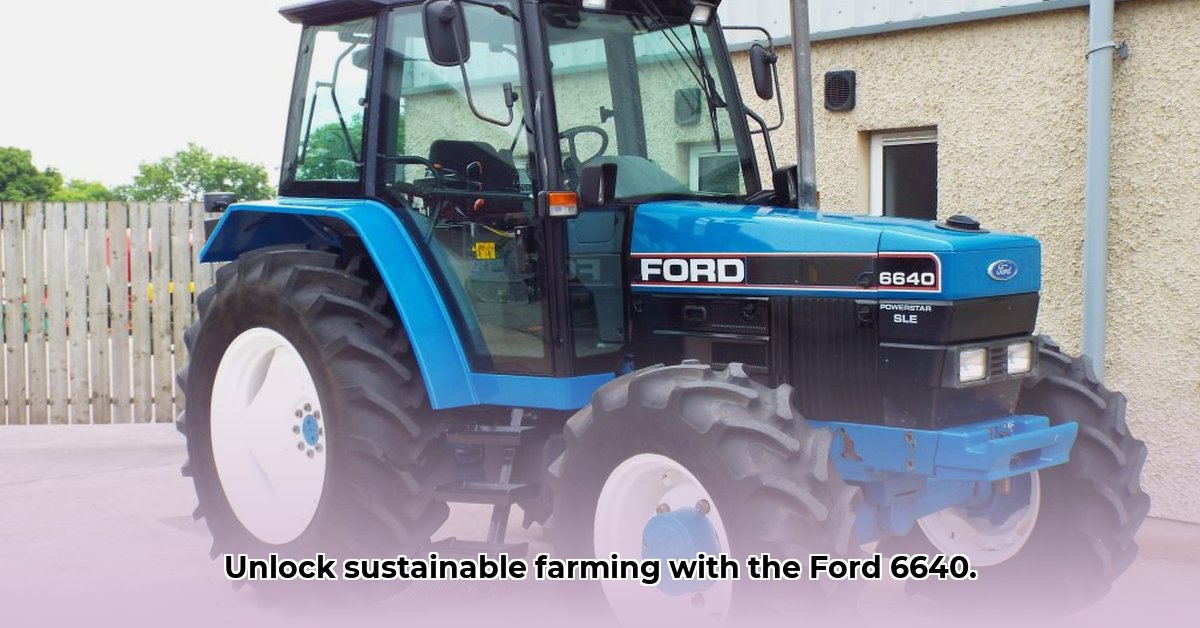
Specifications and Performance: Powering Sustainable Practices
The Ford 6640, a robust tractor produced from 1991 to 1995, offers a compelling case study in sustainable farming practices. Its powerful 5.0-liter, four-cylinder diesel engine, delivering between 85 and 90.7 horsepower (HP), provided sufficient power for various farm operations. The PTO (power take-off; the shaft that transmits power from the tractor's engine to implements) horsepower, ranging from 56.7 to 57.5 HP, was adequate for many implements like balers and tillers. Lift capacity also varied across models, generally between 1905 and 2977 pounds, accommodating a range of agricultural tasks. For more information on Ford tractors, check out this useful resource.
However, a critical limitation arises: precise fuel efficiency data for the Ford 6640 is scarce. This lack of information hinders a comprehensive sustainability assessment, as fuel efficiency directly impacts both operating costs and the tractor's environmental footprint. While we can reasonably anticipate higher fuel consumption compared to modern, more efficient models, a definitive figure remains elusive. This gap in data significantly limits the analysis of its long-term sustainability.
Market Analysis: Navigating the Used Tractor Market
The used Ford 6640 market presents considerable price variability, typically ranging from $8,000 to over $23,000. This fluctuation stems from several interconnected factors:
- Condition: The tractor's overall condition – including wear and tear, necessary repairs, and maintenance history – significantly affects its value. A well-maintained tractor will command a higher price.
- Location: Geographic location influences market dynamics. Higher demand in certain areas can lead to elevated prices.
- Year of Manufacture: Even within the 1991-1995 production window, minor model variations can impact pricing.
The inconsistent availability of reliable pricing data poses a challenge for prospective buyers, underscoring the need for diligent research and thorough pre-purchase inspections.
Sustainability Assessment: A Multifaceted Evaluation
Assessing the Ford 6640's sustainability requires a holistic approach, considering several key aspects:
- Parts Availability: Securing replacement parts for a nearly 30-year-old tractor presents potential challenges. This increases the risk of repair delays and potentially higher costs, impacting operational efficiency and long-term cost-effectiveness.
- Fuel Efficiency: The absence of precise fuel consumption data remains a critical limitation in evaluating the tractor's environmental impact. Higher fuel consumption compared to newer models is likely, resulting in increased operating costs and a larger carbon footprint.
- Maintenance Costs: Older tractors typically demand more frequent and potentially pricier maintenance than modern counterparts. Unanticipated repairs can significantly offset initial cost savings.
- Environmental Impact: A comprehensive lifecycle assessment (LCA) – analyzing the environmental impact from manufacturing to disposal – is necessary for a thorough sustainability evaluation. Such data remains limited for the Ford 6640.
These factors highlight the complexities inherent in assessing the sustainability of older agricultural machinery.
Stakeholder Perspectives: Actionable Insights
Different stakeholders view the Ford 6640's sustainability differently, leading to distinct priorities and considerations:
| Stakeholder | Key Considerations |
|---|---|
| Farmers | Initial cost vs. long-term running costs (fuel, maintenance, repairs); parts availability; potential resale value. |
| Parts Suppliers | Demand forecasting for parts; strategies for sustainable sourcing and remanufacturing; inventory management. |
| Researchers | Conducting LCAs to quantify environmental impacts; gathering data on real-world fuel consumption and maintenance. |
Actionable Steps for Farmers Considering a Ford 6640
- Thorough Pre-Purchase Inspection: A professional mechanic's inspection is non-negotiable to identify potential issues and avoid substantial repair costs later.
- Preventative Maintenance: Implement a rigorous preventative maintenance schedule to maximize the tractor's lifespan and reduce the likelihood of breakdowns.
- Parts Acquisition Strategy: Develop a proactive strategy for sourcing replacement parts, including identifying reliable suppliers and exploring remanufacturing options.
- Fuel Consumption Monitoring: Closely monitor fuel consumption to optimize usage and identify areas for potential improvement in fuel efficiency.
- Responsible End-of-Life Planning: Plan for the responsible disposal or recycling of the tractor at the end of its useful life.
Conclusion: A Balanced Approach to Sustainable Farming
The Ford 6640 presents a nuanced case study in sustainable agriculture. Its robust construction offers potential advantages, but its age and the lack of comprehensive data on long-term costs and environmental impacts require cautious evaluation. Further research into its real-world performance and environmental footprint is essential for informed decision-making within the context of sustainable farming. The sustainable agricultural practice itself also influences the overall impact of the tractor.